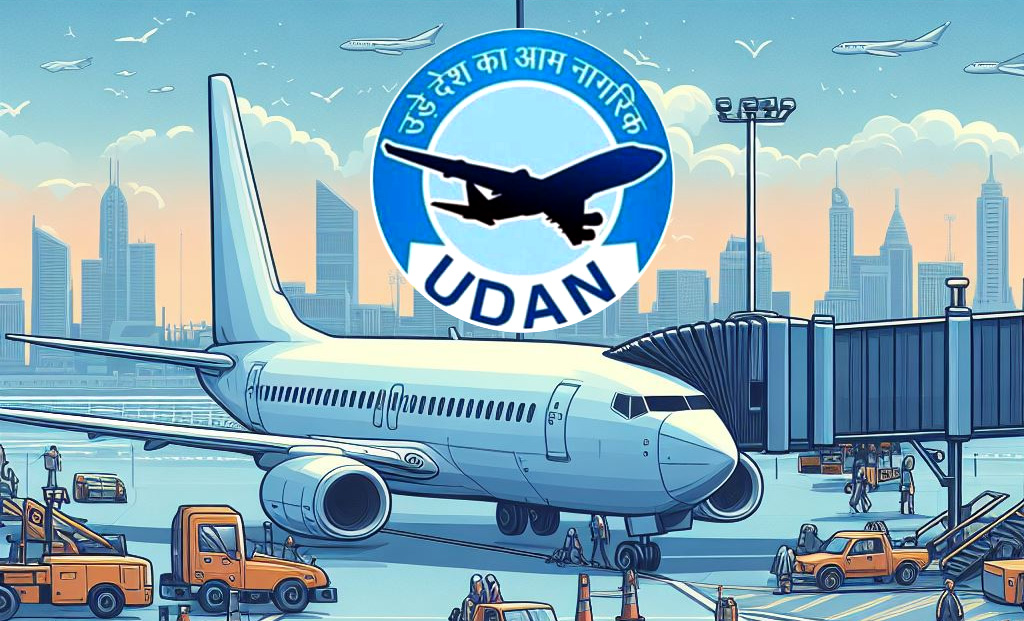- Courses
- GS Full Course 1 Year
- GS Full Course 2 Year
- GS Full Course 3 Year
- GS Full Course Till Selection
- Answer Alpha: Mains 2025 Mentorship
- MEP (Mains Enrichment Programme) Data, Facts
- Essay Target – 150+ Marks
- Online Program
- GS Recorded Course
- Polity
- Geography
- Economy
- Ancient, Medieval and Art & Culture AMAC
- Modern India, Post Independence & World History
- Environment
- Governance
- Science & Technology
- International Relations and Internal Security
- Disaster Management
- Ethics
- NCERT Current Affairs
- Indian Society and Social Issue
- NCERT- Science and Technology
- NCERT - Geography
- NCERT - Ancient History
- NCERT- World History
- NCERT Modern History
- CSAT
- 5 LAYERED ARJUNA Mentorship
- Public Administration Optional
- ABOUT US
- OUR TOPPERS
- TEST SERIES
- FREE STUDY MATERIAL
- VIDEOS
- CONTACT US
UDAN 5.5: Strengthening Regional Connectivity
UDAN 5.5: Strengthening Regional Connectivity
19-03-2025

- The Government of India has launched the latest phase of its flagship regional connectivity scheme – UDAN 5.5 (Ude Desh Ka Aam Naagrik), with a focused approach towards enhancing last-mile air connectivity in remote, hilly, and island regions of the country.
- This phase aims to bridge connectivity gaps in underserved areas by enabling operations through smaller aircraft, helicopters, and seaplanes.
About UDAN Scheme
- The UDAN (Ude Desh ka Aam Naagrik) scheme was introduced by the Ministry of Civil Aviation in 2016 as a key component of the National Civil Aviation Policy (NCAP).
- The scheme was envisioned to transform air travel accessibility for the common man in India’s tier-2 and tier-3 cities.
- Objectives of the Scheme:
- To provide affordable and accessible air travel to the general public.
- To enhance air connectivity to remote and regional areas, thereby promoting regional development and economic growth.
Key Features of the UDAN Scheme
- Airlines operating under UDAN are mandated to cap airfares for 50% of the total seats at ₹2,500 per hour of flight (approximately 500 km).
- The cost differential between the operating cost and revenue is bridged through:
- Viability Gap Funding (VGF): A financial support mechanism provided by the government.
- Concessions and support from both Central and State governments, as well as airport operators.
- Funding Mechanism:
- The Regional Connectivity Fund (RCF) was set up to finance VGF requirements.
- The State Governments contribute 20% to the VGF fund.
- For Union Territories and North Eastern Region (NER) states, the contribution is 10% only.
- For Union Territories and North Eastern Region (NER) states, the contribution is 10% only.
Special Variants under UDAN Scheme
Over the years, the scheme has evolved with specialized formats to cater to diverse connectivity needs:
- Lifeline UDAN: Introduced during the COVID-19 pandemic to ensure timely transportation of medical cargo and essential supplies to remote areas.
- Krishi UDAN: Aimed at improving the value realization of agricultural produce, especially from the NER and tribal districts, by facilitating faster air transportation.
- International UDAN: Designed to establish international air connectivity from the NER, especially from Guwahati and Imphal, to neighboring countries.
UDAN 5.5: Enhancing Last-Mile Air Access
The recently launched UDAN 5.5 phase brings a renewed emphasis on expanding connectivity in difficult terrain and isolated locations.
Key Highlights of UDAN 5.5:
- Targeted at promoting connectivity in remote, hilly, and island regions where conventional aircraft operations are not feasible.
- Routes under this phase will be serviced exclusively by:
- Seaplanes
- Helicopters
- Small aircraft with seating capacity of less than 20 passengers.
- Operators are encouraged to explore new routes involving 80 water bodies, including waterdromes, ponds, and dams, to operationalize seaplane services.
- The scheme also includes 400 helipads across the country, allowing operators to plan chopper routes to improve accessibility in challenging terrains.
Aircraft Categories under UDAN 5.5:
- Category 1A: Aircraft with seating capacity less than 9 passengers.
- Category 1: Aircraft with seating capacity less than 20 passengers.
This category-based participation allows for more flexibility and inclusivity of smaller operators, particularly those specializing in niche aviation segments such as air taxi services, helicopters, and amphibian aircraft.
|
Also Read |
|
| NCERT Books For UPSC | |
| UPSC Monthly Magazine | Best IAS Coaching in Delhi |




